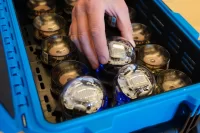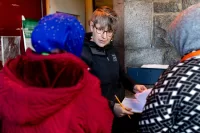
If you wanted to be a popular college student in 1948, you chose Bates.
You chose a Bates bedspread for your dorm room. And matching Bates drapes. And you wore dresses, pajamas, and jackets made from Bates fabrics.
Throughout the late 1940s, back-to-college ads in popular U.S. magazines such as Life and Vogue showcased consumer textiles made by the Bates Manufacturing Co. of Lewiston and marketed by its subsidiary, Bates Fabrics Inc.
The ads featured U.S. college students, including Bates students and future U.S. President George Bush and the late Barbara Bush, lounging in dorm rooms fully appointed with furnishings by Bates Fabrics.
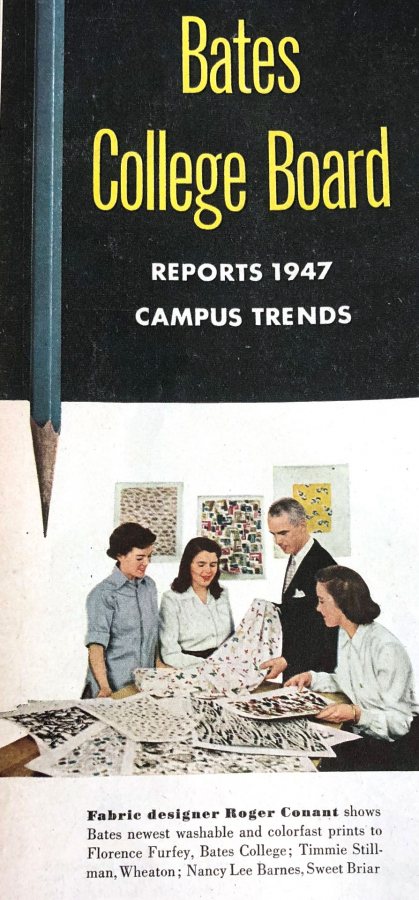
In this detail of a Bates Fabrics ad from the Aug. 17, 1947, issue of Life magazine, Bates College Board member Florence Furfey ’47 reviews “Bates’ newest washable and colorfast prints.”
The college campaign was part of a marketing blitz begun a decade earlier when Bates Manufacturing created Bates Fabrics to market and distribute its consumer goods, especially bedspreads. By the late 1940s, Bates Fabrics was pouring ad dollars into every channel it could find, from print to the new medium of television.
Ads for Bates products were especially common in pop-culture magazines like Life, Mademoiselle, Vogue, Seventeen, and Harper’s Bazaar. (One curious ad, in 1944, featured coifed and elegant Hollywood star Barbara Stanwyck posing next to a Bates bedspread embroidered with log cabins.)
In 1949, the company branched out into television as the sole sponsor of a short-lived NBC show, Girl About Town, featuring one of the medium’s now-forgotten stars, Kyle MacDonnell. Bates Fabrics also sponsored summertime fashion shows at Northeast resorts, where models displayed items made from Bates-made fabrics.
The back-to-college ad campaign is especially distinctive. It’s one of the few times that the narratives of Bates College and Bates Manufacturing came together, albeit briefly.
The campaign was also a sign of the times: an attempt to pivot toward a powerful new demographic — young people — at a time when the company was positioned pretty far from youth: Its famed bedspreads carried the trademarked phrase, “Loomed to Be Heirloomed.”
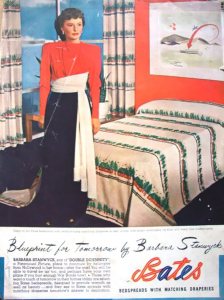
A 1944 magazine ad featured coifed and elegant Hollywood star Barbara Stanwyck posing next to a Bates Fabrics bedspread embroidered with log cabins.
The campaign’s hook was the “Bates College Board.” Not to be confused in any way with Bates College trustees, the Bates College Board comprised college students selected by Bates Fabrics to bring a dose of credibility, if not authenticity, to the ad campaign.
In 1948, the Bates College Board took center stage in a 14-minute film produced by Bates Fabrics to convince local department stores and other buyers to stock Bates goods.
“The Bates College Board,” intoned narrator Ed Thorgersen, well-known as the voice of newsreels, was only the best and brightest, “the smartest young men and women to serve as a board of advisers on taste and style.”
While college surroundings are “lovely,” Thorgersen said, “in all too many cases the rooms they move into are pretty much like a barracks. That kind of a room, Mr. Merchant, is ready for a lot of home furnishings business.”
This edited version of a Bates Fabrics Inc. promotional film, created in 1948, introduces the Bates College Board concept and its members, including Bates student Birgit Svane ’49 and future President George H.W. Bush and the late Barbara Bush. The film has been preserved by Museum L-A, whose mission is to tell the story of work and community in Lewiston-Auburn.
The film touted the firm’s powerful market research, which included focus groups and 8,000-plus questionnaires completed by college students around the country, “so Bates would be up to the minute on what the market wants,” Thorgersen said.
The findings? “The Bates name is over 40 times as famous as any competitor,” he said. “And two out of three prefer a woven bedspread” — information sure to pay off in big sales, he added.
Bates board members came from colleges near and far, big and small, north and south. Colleges represented in 1948 were Bates, Bennington, Northwestern, Rollins, Smith, Stanford, Stephens, Tulane, Yale — represented by George Bush and the late Barbara Bush — and the universities of Michigan, Colorado, Texas, and North Carolina.
The late Birgit Svane ’49 was Bates’ rep in 1948. (She would later marry Paul Libbey and settle in Lewiston, passing away in 2016.) In other years, Florence Furfey ’47 and Jane Waters ’49 were on the board. They, too, are deceased.
With the slogan “Campus Tested. Campus Approved,” the marketing campaign leaned heavily on the idea of popularity and a linked concept, conformity. One Bates Fabrics ad in Life magazine noted that 97 percent of college students believed that “an attractive room helped any Freshman get off on the right foot.”
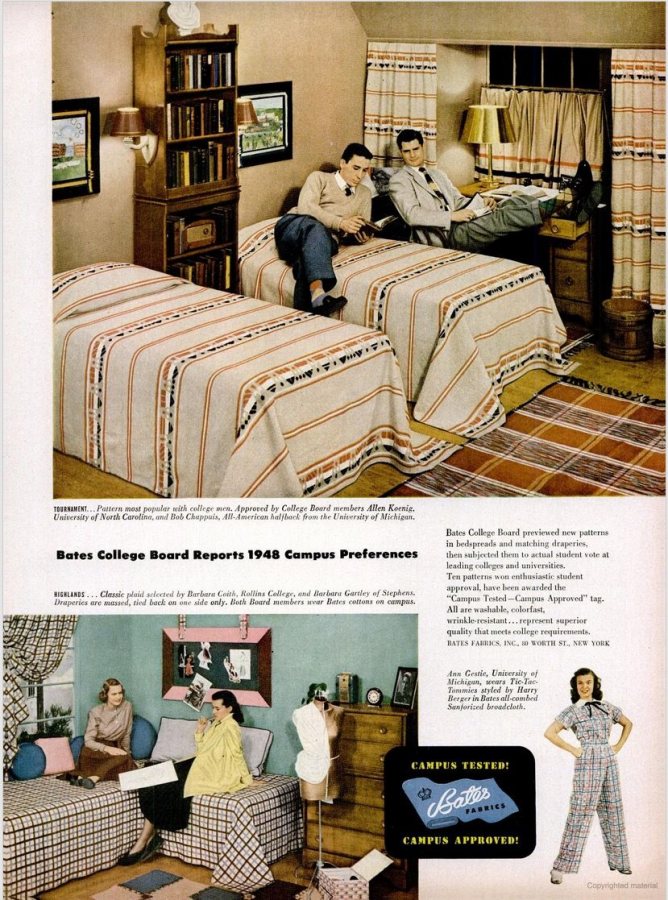
This ad, featuring the Bates College Board showing off items by Bates Fabrics, appeared in the Aug. 23, 1948, issue of Life magazine.
In the film, Thorgersen repeatedly introduced students with the sobriquet “popular,” such as Yale’s “popular Poppy Bush and his wife” and Bennington’s “popular Joan Walls.”
The back-to-college ads were created each February during a junket to Manhattan paid for by Bates Fabrics. Put up at the tony Waldorf-Astoria, the Bates Board worked hard on the photo shoots, and were wined and dined and given the run of the city for a week. Jane Waters told The Bates Student that “most of the week was spent running around in taxis.”
Much of the film was shot during the board’s 1948 visit to New York. In one segment, Bates’ Birgit Svane and Phyllis Berquest of Northwestern model a dorm room featuring a state-flower-themed bedspread, “a bright and popular floral,” Thorgersen said.
“Note the smart trick they’ve done with the draperies — the way they’ve dressed up the bed with state flowers and bright pillows. Tie in with Bates advertising and sell state flowers in your store.”
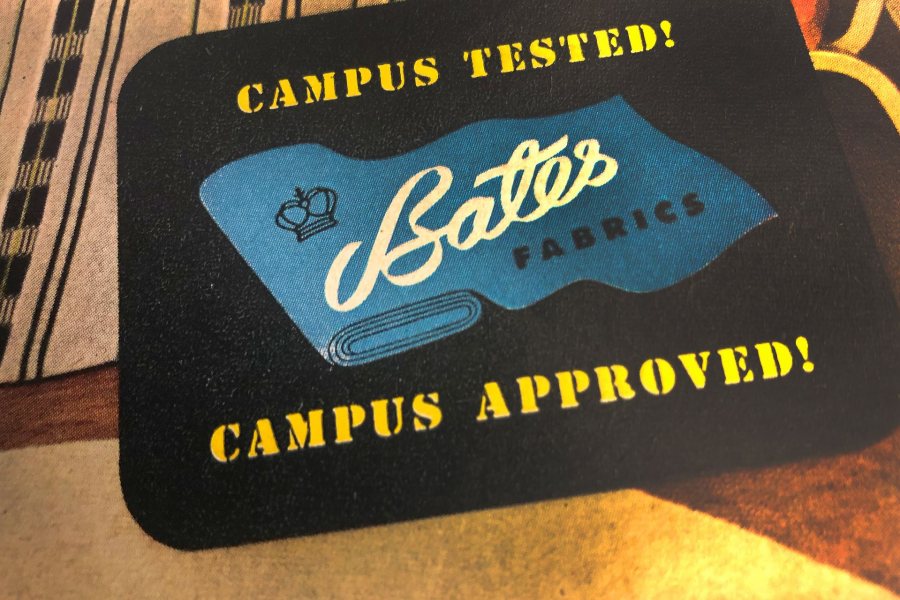
Featuring college students from around the country, including Bates College, the 1940s Bates Fabrics campaign carried this tag line: “Campus Tested. Campus Approved.”
The Big Man on Campus vibe carried over into the print ads. In a 1947 ad in Life magazine, it’s noted that Warren Amling was “twice chosen All-American [and a] student leader at Ohio State.” (He wore a White Stag jacket made with Bates poplin. Once a famous manufacturer of outdoor gear based in Portland, Ore., the White Stag label is now owned by Wal-Mart.)
In 1949, Waters and her fellow board members participated in photo and film shoots for the Bates ad campaign; attended a party at the 21 Club; toured the magazine offices of Mademoiselle; modeled Bates-related clothes in a fashion show; and took in Broadway shows. Waters saw Mister Roberts at the Alvin Theatre (now the Neil Simon Theatre), and As the Girls Go at the Winter Garden Theatre.
By the late 1940s, Bates had sales of $63 million and was a national brand. But already, the American textile industry was fighting hard against the encroaching forces that would mostly dismantle it: Cheaper goods from abroad and a change in American life.
While the Bates goods reflected market research, other evidence suggested that they weren’t hitting the mark. Svane told The Bates Student that while the Bates fashions were nice enough, she and the other women “prefer to hang around in dungarees and shirts (tail dragging, of course) as do the coeds at Bates.”
True: Americans were dressing up less and staying at home more. In 1955, the Economic Report of the President noted that “household life in America is now predominantly casual, both in attitudes and attire.” A casual lifestyle meant that American wardrobe now consisted of “few items” that “last longer.”
